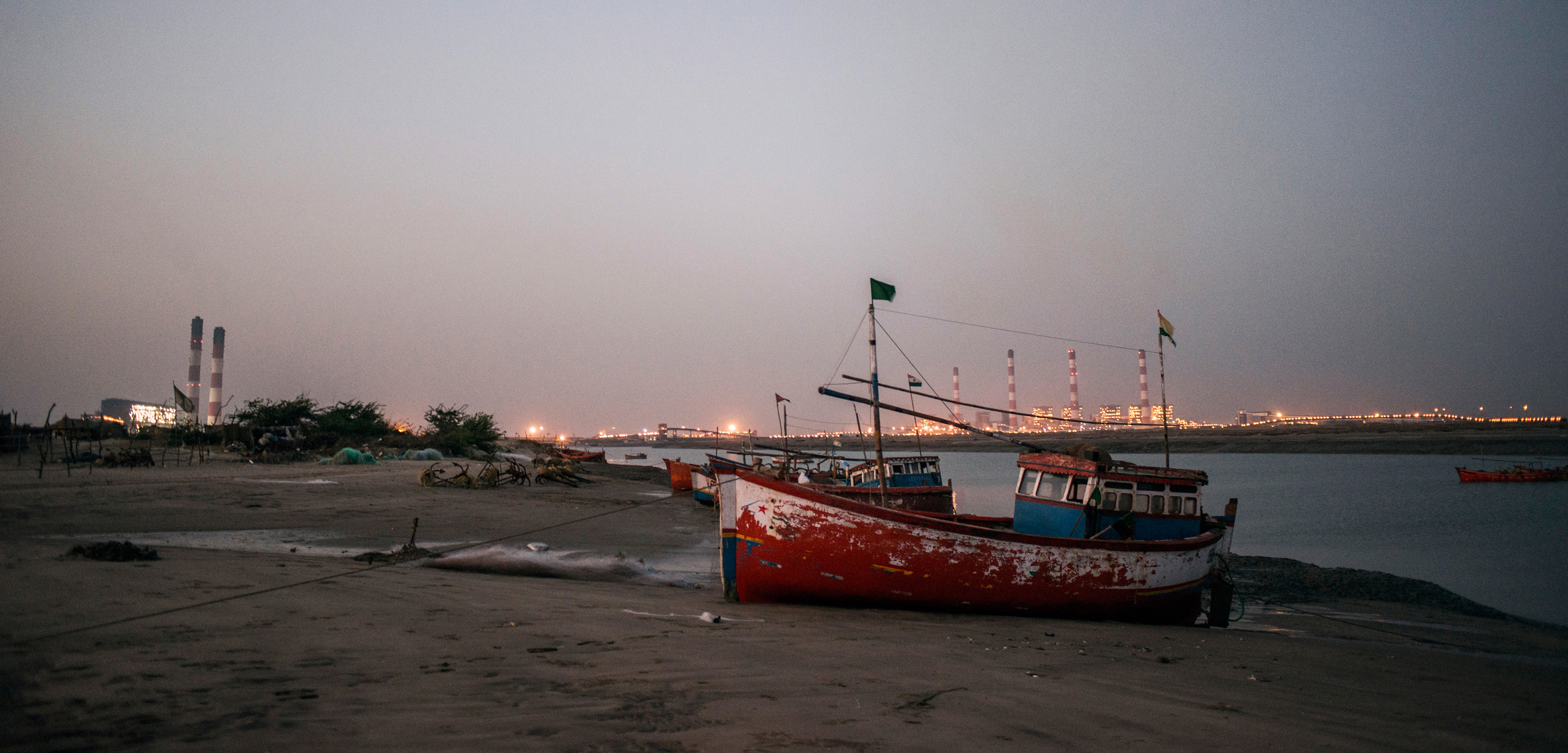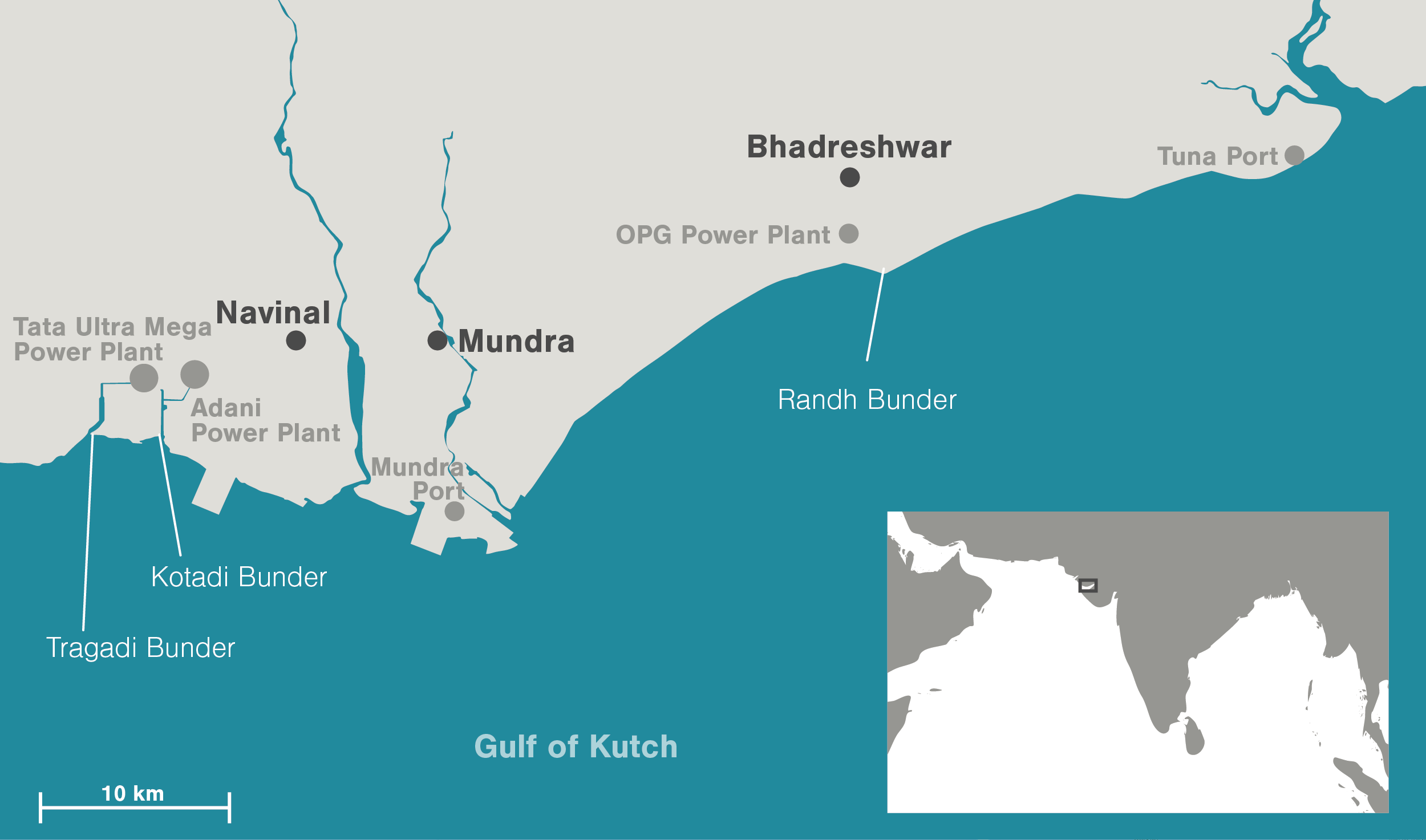The Ultra Mega Powerless Take On the Ultra Mega Power Plants
In India’s Gulf of Kutch, a migratory community of fishers tries to maintain access to the coastline that sustains them.
Article body copy
It’s twilight as Kasam Manjalia rides a donkey cart with bundles of fishing nets by a patchwork of salt pans. He joins his father, Umar, and brother, Husan, on the shoulder of the dirt track, where the pans give way to the Arabian Sea’s Gulf of Kutch, on India’s west coast. The brothers are in their early 20s, and have been fishing with their father since they were children. Kasam puts out hay for the donkey that will wait here a few hours. Two more fishermen who work the same area arrive on a battered scooter. We chat and wait for the tide to recede. It’s fully dark by the time the men roll up their trousers, don bandanas and mud-stained jackets, slip off their sandals, and step down through the packed stones of the breakwater and into the squelch of the mudflat. At first, it’s tough going in the sloppy mud, especially with the bundles of nets they carry on their shoulders, but soon the seabed turns to firm sand and walking is easier. Their destination, the shallow pools left behind by the falling tide, is still two kilometers away.
The Moon hasn’t yet risen. Out on the mudflats, the darkness envelops Umar-bhai (as everyone addresses the older man) and his sons, but visible are various faint sources of light. Some have been around for a long time—the stars of the Milky Way for one. Ahead of me, it looks as though the three men are striding along the galaxy’s fuzzy arm. In the wet sand, our footprints sparkle with bioluminescence. Then, there are more modern sources of light: from out at sea, the dim flicker of trawlers still at work; from land, the pulse of a lighthouse. On the horizon, a disconcerting dotted line of sodium lights marks the port at Mundra; another much shorter line extends from a terminal at Tuna. And behind us in the distance is what looks like a grounded spaceship, a constellation of white fluorescence with red warning lights flashing from a smokestack: the OPG power plant at Bhadreshwar.
Umar-bhai and his sons are Muslim Waghers, a community that fishes along 70-odd kilometers of the Mundra coast, taking advantage of its calm waters and gently sloping seabed. But while the Waghers are fishing people, their permanent villages are inland, sometimes as far as 70 kilometers from their fishing grounds on the gulf’s shore. This evening, Umar-bhai and his sons have traveled by donkey cart and scooter about six kilometers from their home in Bhadreshwar village to fish pagadiya (on foot) using a long net to snag fish from pools of water left by the receding tide. Tomorrow, they will make the round trip again. Better-off families from their village and others have set up makeshift settlements at the edge of the sea called bunders (ports), where they will remain during the fishing season and fish from small boats. The Wagher system of fishing the shallow waters of the Gulf of Kutch has persisted for generations, but now their way of life is threatened. The Mundra coast and the expansive seabed is being claimed for infrastructure and industrial projects, including ports, power plants, and factories. As a result, large tracts of land are now fenced off. Without legal claim to the seasonal seaside bunders they live in for most of the year, some Waghers find themselves displaced from their traditional fishing bases. For others, their path to the sea has been lengthened by a detour or entirely blocked off. Pitted as they are against rapid industrial development, the Waghers live in uncertainty about their future: how can a migratory community of fishers retain access to the coastline that sustains them?
For millennia, humans led nomadic lives, largely as hunter-gatherers. Then, some 12,000 years ago, they began taking to settled agriculture. The rest—literally—is history. But for some cultures, migration remains a way of life. In the Kutch region, for instance, with its largely arid and saline interior, the concept of home is diffuse for several migratory communities. The Rabari people, for example, can walk hundreds of kilometers to find pasture for their goats and sheep, with their kids—livestock and human—riding on inverted cots on the backs of camels. In some cases, entire villages may be found empty because inhabitants have moved to a city to trade. The Wagher way of life, too, is closely connected to the topography of the region of Kutch and the Mundra coast.
The shoreline’s shallow gradient means that the difference between high and low tides is large, exposing the seabed for up to five kilometers when the tide is out. Mangroves serve as breeding grounds for fish, and the nutrients in the intertidal zone ensure a high density of marine life. The water is protected and placid, perfect for fishing from small boats or on foot. While living inland may seem incongruous for a community that survives on the sea, the choice of the Waghers to do so also speaks to their long and intimate relationship with the sea, of understanding its vagaries and the challenges of the coast. Their system of moving between the coast and inland villages seems to have developed due to a number of conditions particular to the region. The Kutch coast is vulnerable to powerful cyclones that could destroy more permanent structures, and the sea itself is in constant flux—fish move, tides rise and fall, storms eat away at the shoreline—so it pays to have bunders that can be moved with some ease.
September to May is the official fishing season. Families gather at the coastal bunders where they live in austere homes—jute sackcloth draped over wood or bamboo frames—assembled on the sand or mudflats, and without electricity, running water, or toilets. At low tide, their small boats—often salvaged from the nearby shipbreaking center of Alang—rest on the exposed seabed. When the tide comes in, the fishermen wade to their boats and set out. They spend a couple of hours diving in the water, laying and retrieving nets. They return with the catch—prawns, pomfret, and plenty of Bombay duck, a type of lizardfish—before the tide goes out again. At the bunder, women sort the catch and children help in hanging the Bombay duck on racks to dry.
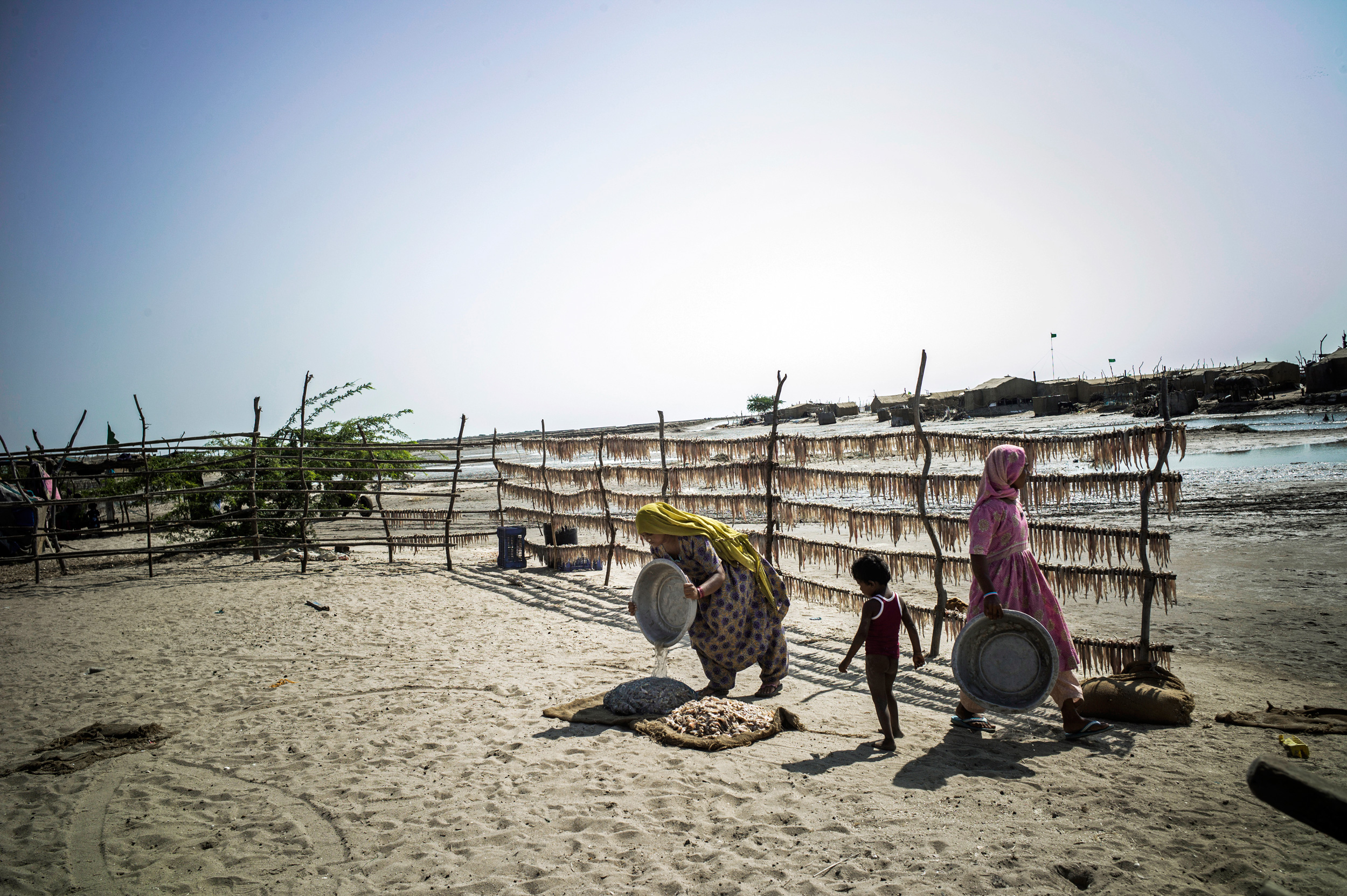
At the Randh bunder near Bhadreshwar village, women collect dried Bombay duck, a type of lizardfish, for sale to wholesalers. Photo by Sami Siva
The entire settlement is dismantled after the fishing season when the Waghers return to their villages. The off-season is a time to make repairs to houses and nets, for weddings and family celebrations. But fishing continues throughout the year, albeit without boats. During the monsoon months, when fish are breeding and both traditional management and the fisheries department prohibit the use of boats, the Waghers live inland and go to the coast to fish pagadiya. Each fisherman installs a net on the seabed in the shape of a V—the arms extending for hundreds of meters or more. When the water recedes, fishermen walk out to their nets to retrieve the catch. (It is their skill with using nets that is believed to give the Waghers their name, derived from the exclamation wah and gher, meaning “well laid out” or “well surrounded” in Kutchi.)
Even though it’s the official fishing season and using a boat is permitted, Umar-bhai and his sons fish on foot. Owning a boat and living in a bunder is beyond their reach and that of many other villagers. So, most days, they commute to the coast, timing their arrival to match the departing tide.
After a half hour of walking, the sea begins to slosh around our ankles. The men stop and wait silently. We’re just a little early. A lifetime of fishing in the area gives them a running sense of the tide, the ability to anticipate its progress by instinct, without resorting to charts and tables. Tomorrow, for instance, Umar-bhai says they’ll start off from home a little later to account for the shift in the tide’s timing. The water recedes farther and after about 10 minutes they walk on. Ankle-deep mud marks the beginning of the area they’re interested in—a still, shallow pool, more a sprawling puddle, really. But with fish trapped in it.
The trio unpacks a net, 60 or 70 meters long, and vanishes into the darkness. After about 15 minutes, torchlight is visible about 100 meters away, and the three men emerge, dragging the net from both ends and the middle. At the edge of the lagoon, one of them holds the sides of the net and makes a winnowing motion along the length so the entire catch accumulates in one writhing pile. Eels, an octopus, crabs with too little flesh, and a furiously flapping stingray are tossed aside. They place the prawns, blue crabs, and mullet in net pouches, to be sold to a fish trader in the village in the morning. Then they move on to another part of the seabed.
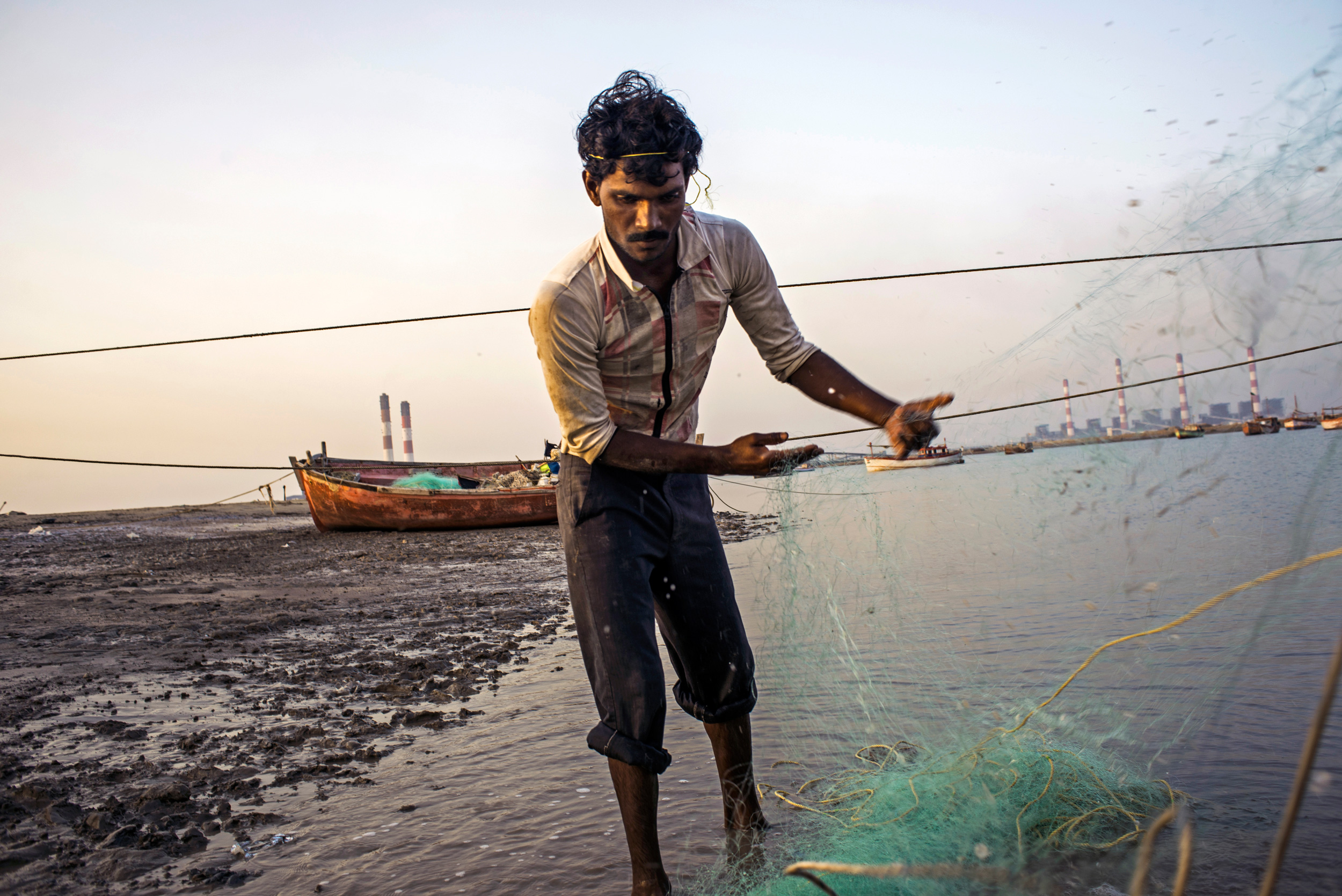
Many Wagher fishermen fish pagadiya, on foot, using large nets deployed by hand in the shallow waters of the Gulf of Kutch. Photo by Sami Siva
For Umar-bhai, Kasam, and Husan, their commute to the coast has remained largely unchanged, although since the seabed was diked and converted to salt pans in the past few years, they now must travel about a kilometer farther to reach it. But other Wagher fishermen are not so lucky. A visible sign of this comes a few kilometers west, on the road between the villages of Luni and Sekhadiya. A concrete and barbed wire fence runs on and on alongside the road, interrupted at one place by a gate with a security checkpoint. There, a sign reads: “Entry only for fishermen & devotee & darga,” the latter two words referring to a shrine beyond. The sign marks a small victory for the fishermen amid troubles that began when they found themselves in the direct path of India’s push toward industrial development (or, at least, a particularly aggressive manifestation of it).
To go by history, the Wagher fishers are doubly vulnerable to the changes happening around them. For one, from the Americas to Australia, things have seldom worked out well for indigenous fishers whose coastlines became part of larger designs. (Take the city of Mumbai, a few hundred kilometers south of the Kutch region. The British developed it into a trading port from the 17th century onward, and entire fishing villages belonging to its longtime inhabitants became landlocked as the city grew through reclamations from the sea.) And then, when settled and nomadic lifestyles have rubbed against each other, notions of land ownership and private property have routinely caused problems. As small-scale fishers who also happen to lead migratory lives, the Waghers are up against both tendencies.
The Waghers’ home region of Kutch has become attractive for industrial development thanks to many of the same attributes that shape the lives of its people. The calm gulf and the large intertidal zone—land that can easily be reclaimed from the sea—are essential to the Waghers, but they also make the coast suitable for industrial ports. And proximity to the coast means an endless availability of seawater, useful for thermal power plants and other industry. As well, land with small and largely migratory populations is easier to acquire in large tracts, especially when the legal hold to land is tenuous at best.
This wave of industrialization along the Mundra coast started in the late 1990s, when the first port began operations amid reports of violations of industrial and coastal regulations. The port was partly run by a business conglomerate, the Adani Group. In 2005, the Indian government brought into law the Special Economic Zones (SEZ) Act with a view to attracting foreign investment. An industry in an SEZ was “special” in that it would enjoy tax and procedural incentives. A company with the requisite land and a recommendation from the state government could apply to develop an SEZ, and if approved they would prepare the land for use by industries and lease it to them at a profit. In 2006, the Indian government approved a proposal by the Adani Group to develop an area of 24 square kilometers in Mundra as an SEZ, which has since been expanded at regular intervals (along with equally regular accusations of it being a land-grab with state government collusion). The planned extent of the SEZ is now 150 square kilometers, with the land acquired from the limits of 14 villages in the Mundra area. Of this, 84.81 square kilometers have already been approved by the Indian government— and fenced off by the Adani Group—as part of the SEZ. By 2013, the Mundra port—the same one that lights the horizon off Umar-bhai’s fishing grounds—was the busiest of India’s more than 200 ports.
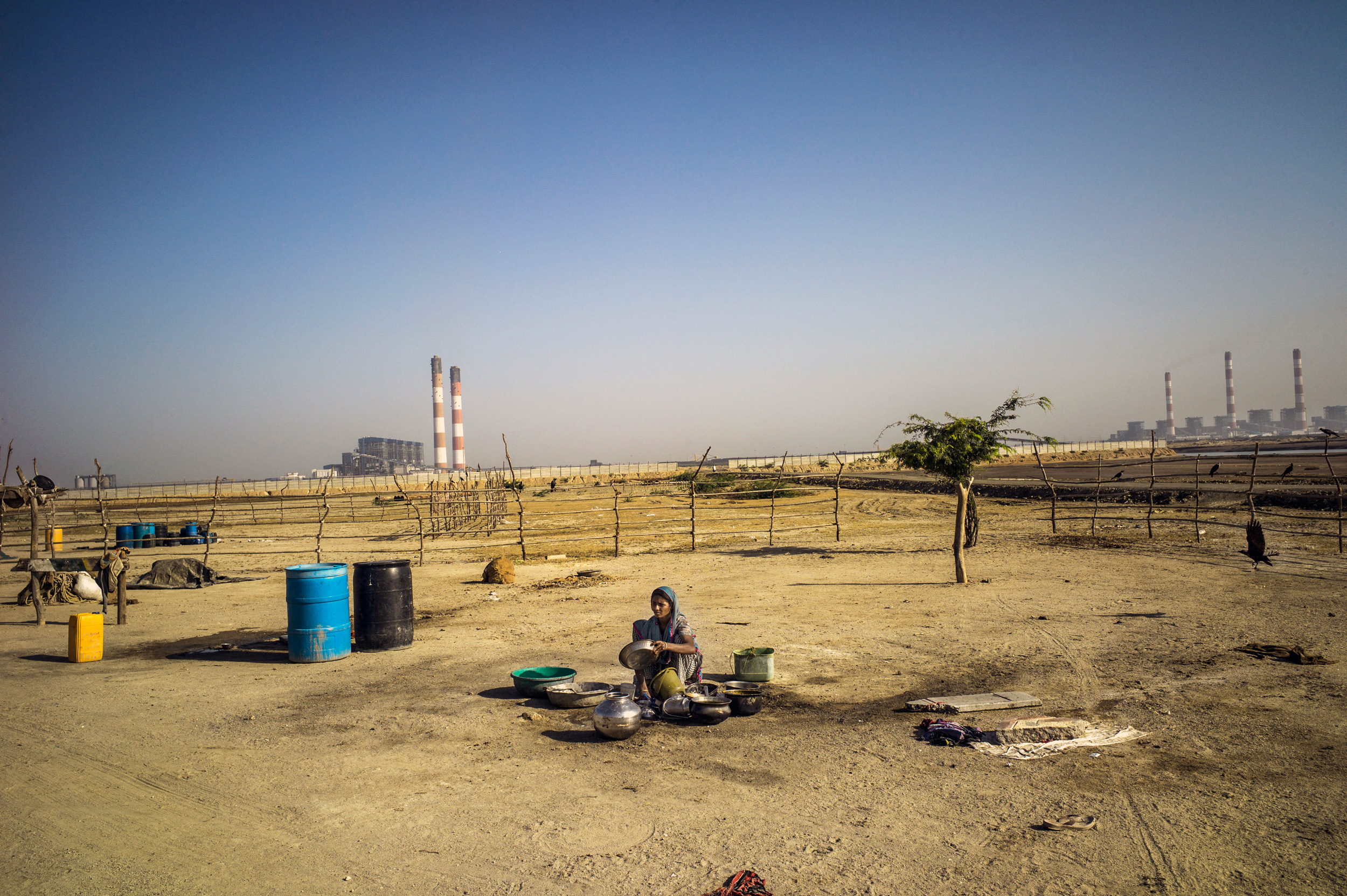
In the shadow of one of the many power plants that dot the west coast of India, a woman goes about her work in a seasonal bunder. Wagher fishers have permanent villages inland, but live in simple structures on the coast during the fishing season. Photo by Sami Siva
The trouble for the Wagher fishers is that they do not have any legal claim to their bunders or to the paths they use to reach the sea. Their attempts over the decades to secure access to the coast have led nowhere—likely because the Waghers are socially and economically marginalized, and invisible in the larger scheme of things. (Indeed, at least one report has an Adani Group spokesperson claiming in 2009 that there was no fishing activity on the coast, an assumption also found in Tata Power’s environmental impact assessment for their power project in the SEZ.) Kiritsinh Jadeja, a Bhadreshwar village leader says, “It’s the government’s work to take care of the fishermen’s rights.” In his view though, the government is more easily persuaded to help industrialists, who have the advantage of what he calls “money power.” Besides, he says, the fishers lack formal education, the result of spending most of the year out on the bunders. This leaves them ill-equipped to comprehend government notifications, raise objections, and pursue legal redress. Usmangani Sherasiya, a longtime community worker in the area, points out that it doesn’t help that the Wagher fishers in Mundra are Muslim. Political power is concentrated in the hands of Jains—who by tradition are vehemently opposed to the taking of all life, and so tend to be disapproving of fishers—and the Hindu Darbar community, neither of which is likely to represent the Waghers effectively. That leaves activists and nongovernmental organizations.
At the forefront of the battle for Wagher access to the shoreline is the trade union MASS, the Machimar Adhikar Sangharsh Sangathan (Association for the Struggle for Fishworkers’ Rights). In 2007, for example, when the Adani Group began working on an airstrip near Shekadiya village that would block access to a pagadiya fishing zone, MASS protested for over a month in front of the block magistrate’s office. The union finally backed down when fishers were granted an access road through the fenced-off land, though it was “access” mediated by a gate and a security checkpoint.
For MASS and other critics, most disconcerting is the way land was acquired for the SEZ in the first place. The opposition in the Gujarat State Assembly and several journalists have accused the government of colluding in a land-grab by offering land at unusually low rates to the Adani Group. Environmental activists and fishers have suggested that the Adani Group submitted plans for approval that showed a high tideline up to 10 kilometers outside its actual position, with embankments being built to distort the high tideline. They’ve also pointed out instances of dredging, seabed reclamation, mangrove destruction, flattened sand dunes, and blocked creeks, as well as the construction of large projects, including a township and a hospital, all without requisite permissions or in violation of regulations that protect coastal land. In response, the Indian Ministry of Environment and Forests formed a committee to investigate. Their 2013 report confirmed several violations, and the ministry imposed a two-billion-rupee (about US $30-million) fine on the Adani Group. Independently, in January 2014, the Gujarat High Court deemed that its 2012 order to halt all construction and development work in the SEZ until environmental clearances had been approved was ignored. It ordered 12 operations in the SEZ to suspend work until the environment ministry gave its approval. The 2012 ruling was in response to a suit from 2011. The sequence is part of a cycle that’s become all too familiar since the 1990s: violations, followed by fines and conditional clearances, followed by more violations. This time, approval was received in July 2014, subject to 21 conditions, including directives to set aside land for cultivating mangroves, not to modify the course of rivers, not to disturb sand dunes, and the somewhat optimistic order to restore affected creeks to the condition seen in satellite imagery from 2005.
The creeks are key resources for the Wagher fishers, and the court ruling was a response to a case filed by Gajendrasinh Jadeja, the sarpanch (village council head) of Navinal village, which falls entirely within the SEZ. In his office, Jadeja opens up Google Maps on his laptop and shows how the fishers used to access the sea by walking one and a half kilometers to a creek and then taking their boats onward. Pagadiya fishermen harvested the area around the creek. Now, a wall blocks their path to the creek, and even if it didn’t, bridges built on the creek would not allow boats to pass. Fishermen have to take a circuitous path of about 25 kilometers to reach their boats.
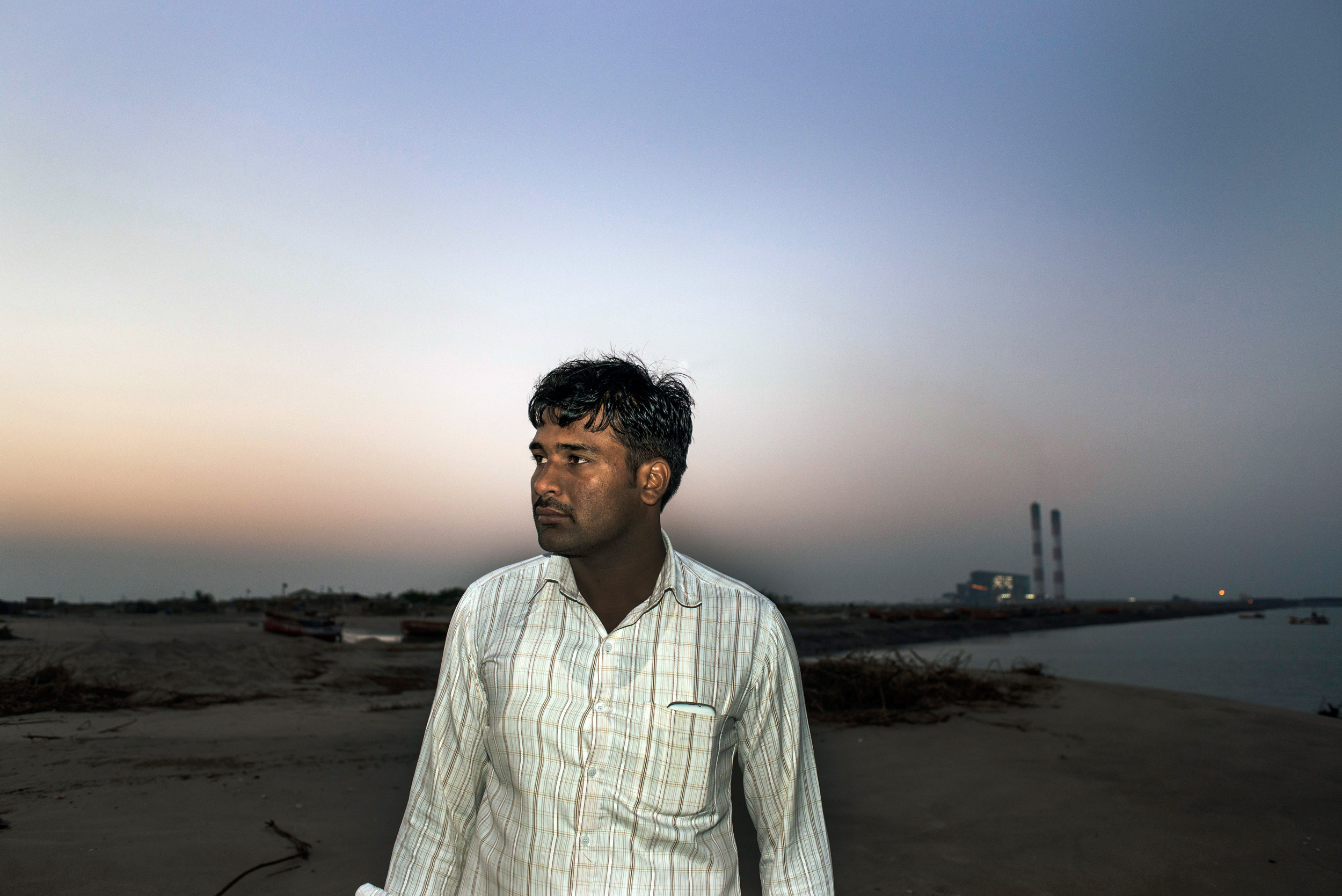
Gajendrasinh Jadeja, the sarpanch (village council head) of Navinal village poses for a photograph with the Tata power plant in the distance. Photo by Sami Siva
“We were fighting to save our land,” says Jadeja, whose village also lost grazing land to the SEZ. For his troubles, he was arrested and suspended from his council position. (He accused the district administration of having him arrested at the behest of the Adani Group; the Gujarat High Court subsequently ruled that his arrest was unwarranted and ordered his release.) In this case, periodic judicial victories have not helped the Waghers: pagadiya fishing in the area has been wiped out. A little to the southwest, the entire Kotadi bunder has been relocated to make way for a channel to draw water for two thermal power plants—the Adani Power’s Mundra Thermal Power Station and the 4,150-megawatt Tata Power’s Mundra Ultra Mega Power Project.
Near the outflow channel of the Tata plant is the Tragadi bunder, where about 400 people live in 60 homes. It’s around noon and Iqbal Manjalia, a young man who fishes with his brother and father, has brought home the day’s catch. His mother, Hajraben, sorts through the pile in the net. “This bunder is all we have,” she says. “If it goes away, we will have nowhere to fish.” Iqbal adds, “We have no proof that this is our land. We were here first, but now the land belongs to Tata. If they ask us to leave, we will have to.” For its part, Tata has arranged for a water tank, built a mud road, and organized occasional health clinics for the bunder’s residents. Asked about the possibility that fishers like Iqbal may be asked to leave someday, a representative of Tata Power said that they “believe in stakeholder engagement and before taking any decision, it will be discussed with the residents first.”
Hajraben has been sifting through her family’s fishing nets for more than 25 years. She says that since the arrival of the Tata plant, she is seeing fewer and smaller fish. Wagher fishers across the 10 bunders on the Mundra coast report similar experiences, and a fish trader at Bhadreshwar estimates a 40 percent decline in the catch brought to him over the past decade. Part of this the fishers attribute to the destruction of mangroves, but the major culprits in their reckoning are the power plants, which they believe kill young fish in the water they take in and cause further harm when they release warm water into the sea. “The fish have gone far away,” says Iqbal.
“I won’t be surprised if this is happening,” says Naveen Namboothri, a marine biologist who has studied intertidal ecosystems and is director of the Dakshin Foundation, a Bangalore-based NGO working toward conservation and management in coastal and marine ecosystems. He says that while nothing conclusive can be said without studying the particulars of the ecosystem in question, what the fishers describe is plausible. Extensive habitat destruction, as with mangroves, is known to change the distribution of fish in surrounding waters. And large volumes of warm water released into the sea can form a thick layer at the surface due to its lower density, which can act as a barrier for fish dispersal and movement.
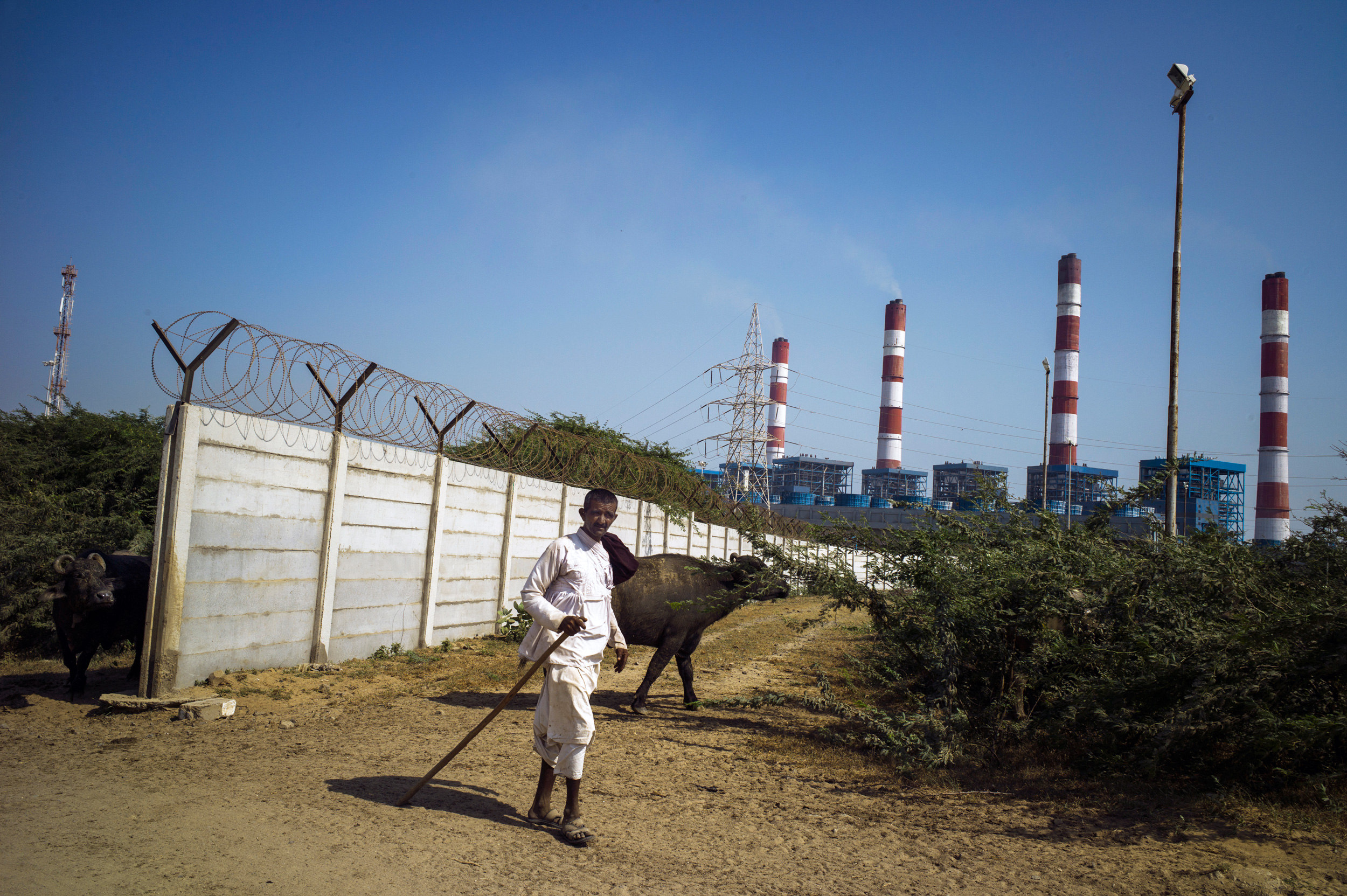
In theory, local people retain rights of access to parts of the shoreline, but in practice, extensive fences mean they must take longer, roundabout routes to the coast. Photo by Sami Siva
Certainly, the outflow channel of the Tata plant deals in large volumes. It looks like a wide river. The pumping system’s manufacturer claims it is the world’s largest water circulating system, capable of discharging 10.5 million liters of warm water into the Gulf of Kutch every minute. Fishermen in the Tragadi bunder, adjacent to the outflow channel, say they no longer feel cold when they enter the water in winter.
In 2009, the OPG power plant visible from Umar-bhai’s fishing grounds sought to lay water channels through the Randh bunder, which is situated behind the plant. The fishers united under MASS and other organizations, and began a fierce protest. For four years, there were marches, rallies, even clashes with the SEZ’s security force leading to 30 fishermen being jailed. The protesters prevailed and the plant opened in 2015 after changing its design to an air-cooled system that requires little water. In another battle, in 2011, the fishers through MASS filed a complaint with the ombudsman of the International Finance Corporation (IFC), an arm of the World Bank that partly financed the Tata power plant. The fishers argued that the disruptive effects of the project on their lives and surroundings had not been taken into account by the IFC. The IFC’s ombudsman twice sent teams to Mundra before issuing a scathing report that concluded that the Muslim Wagher fishers were not adequately considered when environmental and social impacts of the project were evaluated. But no real action resulted. Bharat Patel, founder of MASS, says that the committees and panels that visit the area all put out reports supportive of the Waghers. “But,” he says, “nothing happens on the ground.”
As with so many projects in India, development along the Mundra coast seems to come at the expense of the most vulnerable. (It’s worth noting that despite their lives being disrupted by looming power plants, not one of the bunders has electric power.) Even among the Waghers, it is the smallest fishers, the pagadiya, who are worst affected by the recent changes. Bharat Patel says, “Industrial and salt pan encroachment are having an impact. Pagadiya fishing grounds are running out.” In 10 years, he feels the pagadiya fishing practiced by Umar-bhai, his sons, and others might well be finished.
For now though, the Wagher fishers manage to get by. Out on the seabed, Umar-bhai assesses the catch by torchlight after the trio drags its net in the second time. “Not so good today,” he says. “But some days it’s good, some days it’s not. That’s the fisherman’s life.”

